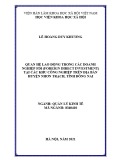
95
HNUE JOURNAL OF SCIENCE
Social Sciences 2024, Volume 69, Issue 4, pp. 95-102
This paper is available online at https://hnuejs.edu.vn/
DOI: 10.18173/2354-1067.2024-0071
ATTRACTING FOREIGN DIRECT INVESTMENT FOR DEVELOPMENT
ECO-INDUSTRIAL PARK MODEL IN THE RED RIVER DELTA
Pham Ngoc Tru
Office of Testing and Quality Assurance, Academy of Policy and Development,
Hanoi city, Vietnam
Corresponding author: Pham Ngoc Tru, e-mail: phamngoctru@apd.edu.vn
Received November 6, 2024. Revised November 27, 2024. Accepted November 28, 2024.
Abstract. This research proposes strategic solutions for attracting Foreign Direct Investment
(FDI) to develop eco-industrial parks in the Red River Delta region through 2030, with a
vision for 2050. The author's proposed solutions are grounded in a comprehensive analysis
of the current status and developmental trends of eco-industrial park models, forecasted
impacts of international and domestic contexts on FDI flows, and the competitive advantages
of the Red River Delta region in attracting FDI specifically for eco-industrial parks.
Regarding the development plan, the research focuses on proposing spatial distribution
strategies across two sub-regions, the optimal number of industrial parks, and parks as well
as the orientation to attract key industries in eco-industrial parks. To enhance FDI attraction
effectiveness for eco-industrial park development, the author proposes concentrated
implementation of solutions in three critical areas: infrastructure modernization, specialized
development support policies, and regional linkages in promoting foreign direct investment.
Keywords: foreign direct investment, eco-industrial park, the Red River Delta.
1. Introduction
An eco-industrial park is an industrial zone where enterprises participate in cleaner
production, use resources efficiently, and collaborate to carry out industrial symbiosis activities,
all following criteria specified in the relevant decree [1]. Specifically, Decree No. 35/2022/ND-
CP, issued by the Government, regulates the management of industrial parks and economic zones.
It defines criteria concerning the activities of primary investors (those responsible for building
and managing industrial park infrastructure) and secondary investors (those engaged in
production and business operations within industrial parks). The decree also mandates a minimum
of 25% of the park area to be allocated to green spaces, transportation, technical zones, and shared
social infrastructure, as well as other facilities (housing, service structures, etc.).
In Vietnam, research on eco-industrial parks remains limited, focusing mostly on the concept
of eco-industrial parks and experiences with this model in other countries. For instance, Nguyen
Cao Lanh (2005) proposed eco-industrial parks as a model for sustainable development in
Vietnam [2]. Additionally, Do Dieu Huong et. al summarized key theoretical and practical
insights on eco-industrial park development worldwide and assessed the feasibility of
implementing this model in Thang Long II Industrial Park, Hung Yen Province [3]. On the topic
of the attraction of foreign direct investment into Vietnamese industrial parks, many studies have
suggested strategies for attracting FDI at the provincial level, such as Pham Van Cuong’s research

























